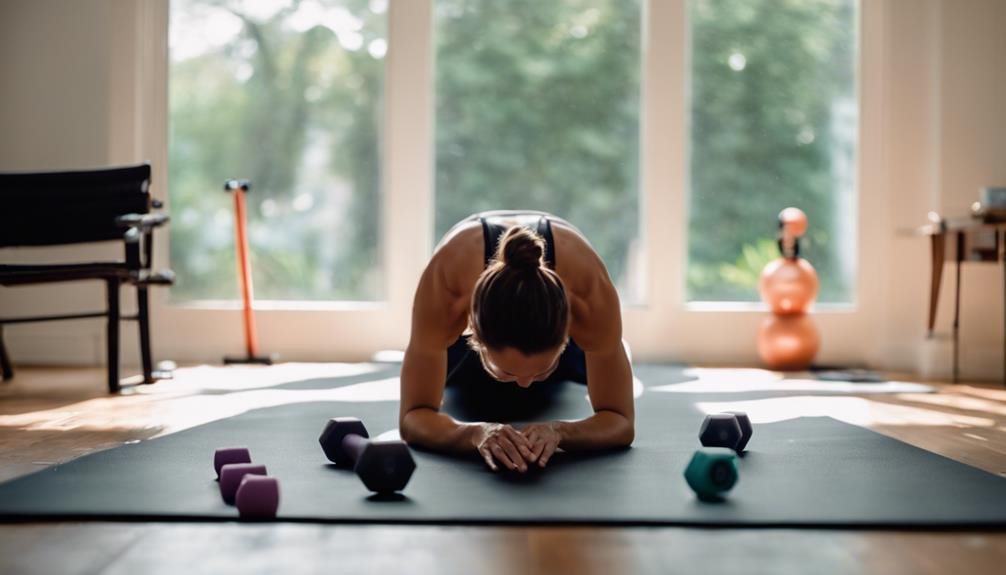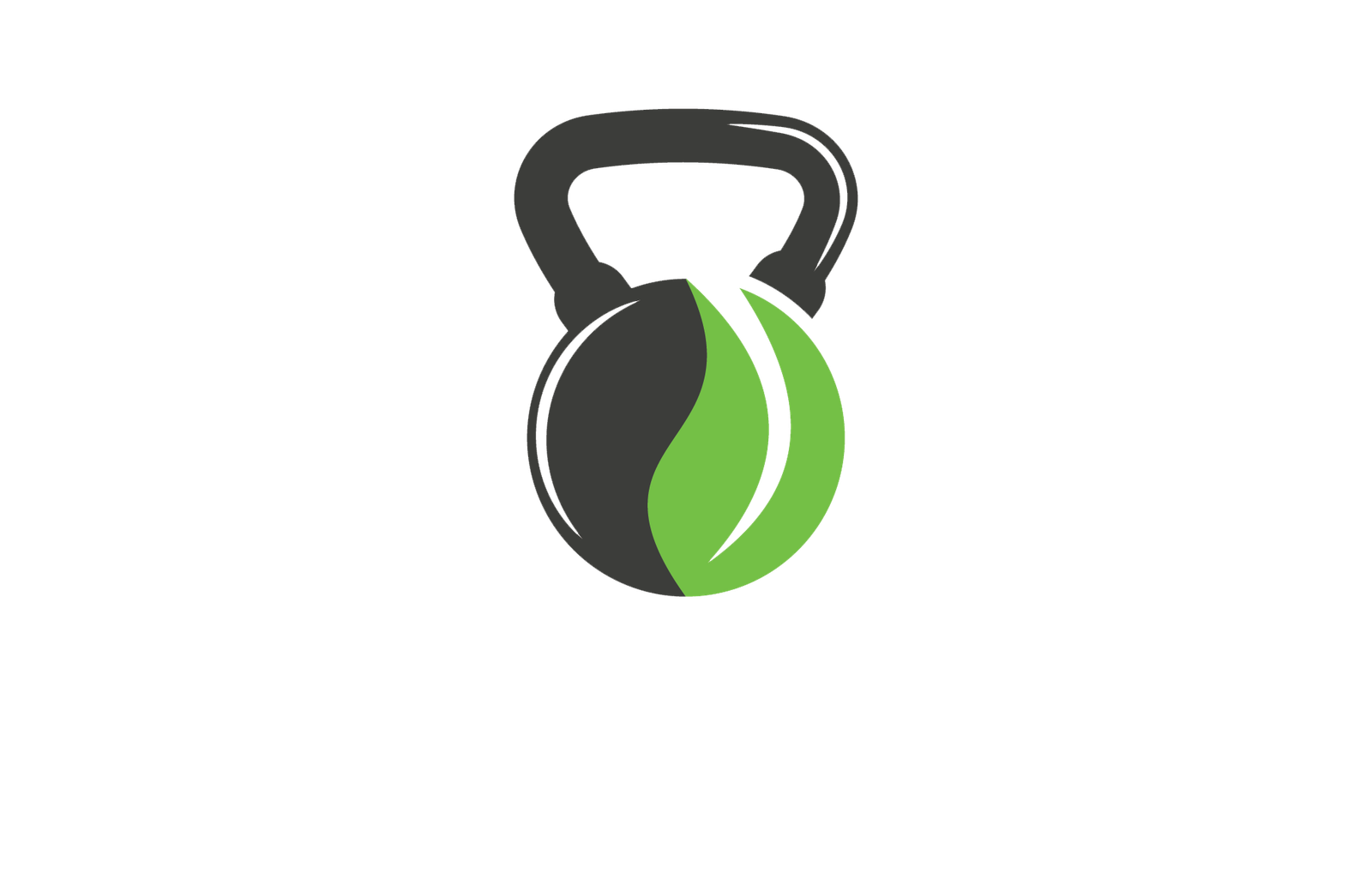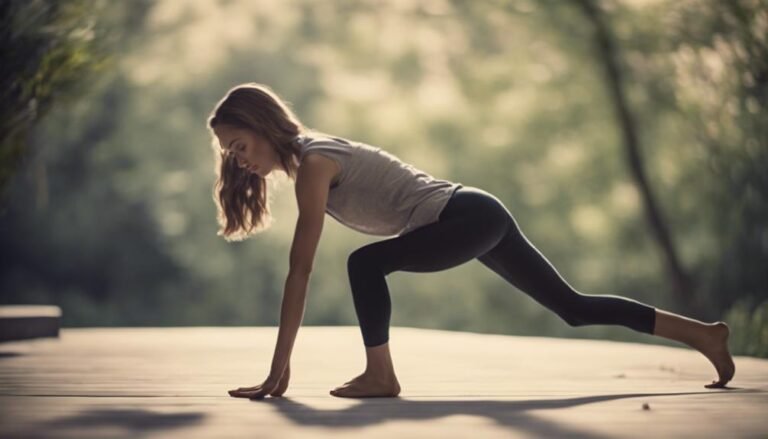Don't miss our holiday offer - 20% OFF!

Flexibility Routines to Enhance Your Home Workouts
Nurturing flexibility routines can revolutionize your home workouts, but are you making these common mistakes that hinder progress?
We're taking our fitness journey to the next level by incorporating flexibility routines that will enhance our home workouts, boost our overall performance, and leave us feeling more energetic and empowered. By implementing dynamic stretching, foam rolling, yoga poses, Pilates, and static stretching, we'll improve our posture, reduce injury risk, and increase our range of motion. We'll also alleviate chronic pain, reduce muscle soreness, and even enhance our athletic performance. As we dive deeper into the world of flexibility exercises, we'll discover tailored routines to suit our busy schedules, avoid common mistakes, and create balanced flexibility routines that will transform our bodies.
Key Takeaways
- Incorporate dynamic stretching exercises like leg swings, arm circles, and hip openers into your warm-up routine to enhance flexibility and prepare your body for physical activity.
- Use foam rolling to reduce muscle soreness, improve circulation, and promote faster recovery after home workouts.
- Incorporate yoga poses like Downward-Facing Dog and Seated Forward Fold into your routine to improve spinal alignment, reduce stress, and increase flexibility.
- Practice Pilates exercises that focus on core control to improve posture, reduce back strain, and enhance overall flexibility.
- Make time for static stretching exercises to provide instant relief from muscle tension and soreness, and to promote relaxation and muscle relaxation.
Importance of Flexibility Exercises
As we set out on a journey to improve our flexibility, it is essential to recognize that incorporating flexibility exercises into our daily routine can have a profound impact on our overall health and wellbeing. By understanding the flexibility fundamentals, we can debunk common exercise myths and tap into the full potential of our bodies. For instance, many of us believe that flexibility is solely reserved for gymnasts and dancers, but the truth is, flexibility is essential for everyone, regardless of age or fitness level.
Incorporating flexibility exercises into our daily routine can improve our posture, reduce injury risk, and even enhance our athletic performance. Additionally, flexibility exercises can help alleviate chronic pain and improve our overall range of motion. By making flexibility a priority, we can improve our overall quality of life and feel more energetic, confident, and empowered. So, let's get started on this journey to improve our flexibility and reveal a stronger, healthier, and happier us!
Dynamic Stretching for Warm-Ups
As we move on to dynamic stretching for warm-ups, we're excited to explore the three key components that will take our flexibility routines to the next level. We'll start with muscle activation exercises that get our bodies ready for action, followed by movement preparation drills that mimic the movements we'll be doing. Then, we'll focus on injury prevention stretches that help us avoid common pitfalls and stay healthy.
Muscle Activation Exercises
We kick off our exercise routine with muscle activation exercises, a dynamic stretching technique that gets our bodies ready for physical activity by firing up the right muscles. These exercises are essential for peak performance and injury prevention. By incorporating muscle activation exercises into our warm-up routine, we can confirm that our core is engaged, and our muscles are rebooted for maximum efficiency.
Plank | Core | Improves posture, reduces back pain
Glute Bridges | Glutes | Strengthens glutes, improves hip alignment
Leg Raises | Lower Abs | Strengthens core, improves balance
Arm Circles | Shoulder Stabilizers | Improves posture, reduces shoulder tension
Calf Raises | Calf Muscles | Improves ankle mobility, reduces calf strain
Movement Preparation Drills
Now that our muscles are activated, we're ready to move into our movement preparation drills, a dynamic stretching routine that gets us ready to perform at our best while reducing the risk of injury.
These drills are designed to mimic the movements we'll be doing during our workout, preparing our muscles for the demands ahead. By incorporating movement screens, we can identify any limitations or weaknesses that may hinder our performance or increase our risk of injury. This allows us to tailor our drill progressions to address these areas, ensuring we're adequately prepared for our workout.
Here are three key movement preparation drills to incorporate into our routine:
- Leg Swings: Stand with our feet hip-width apart and swing one leg forward and backward, then switch to the other leg.
- Arm Circles: Hold our arms straight out to the sides and make small circles with our hands.
- Hip Openers: Stand with our feet together and take large steps to the side, keeping our knees straight.
Injury Prevention Stretches
With our movement preparation drills complete, we're ready to shift our focus to dynamic stretching, a key component of our warm-up routine that helps prevent injuries by increasing blood flow and range of motion. As we embark on dynamic stretching, we're taking proactive preventive measures to safeguard our bodies from potential injuries. By incorporating stretching fundamentals into our routine, we're not only enhancing our flexibility but also building a strong foundation for our workouts. Dynamic stretching is all about movement-based stretches that mimic the actions we'll perform during exercise. We're talking leg swings, arm circles, hip rotations, and more. These exercises get our hearts rate up, loosen our muscles, and prepare our joints for the impending exercise. By incorporating dynamic stretching into our warm-up, we're taking a vital step towards injury prevention. By committing to these exercises, we're investing in our long-term fitness goals and setting ourselves up for success. So, let's get moving and make dynamic stretching a non-negotiable part of our workout routine!
Foam Rolling for Muscle Recovery
Rolling out our tight muscles with a foam roller is a game-changer for post-workout recovery, allowing us to bounce back faster and stronger. By incorporating foam rolling into our routine, we can reduce muscle soreness, improve circulation, and even enhance our overall athletic performance. This self-myofascial release technique helps to break up muscle knots and adhesions, leaving our muscles feeling looser and more relaxed.
Here are three key benefits of foam rolling for muscle recovery:
- Reduced muscle soreness: Foam rolling helps to reduce delayed onset muscle soreness (DOMS) by increasing blood flow and breaking up muscle knots.
- Improved circulation: By rolling out our muscles, we can improve blood flow and reduce inflammation, which aids in the removal of waste products and promotes faster recovery.
- Enhanced athletic performance: By reducing muscle tension and improving circulation, foam rolling can help us perform better in our workouts and competitions.
Yoga Poses for Improved Flexibility
As we move forward in our flexibility journey, we're excited to explore the incredible benefits of yoga poses that can transform our bodies. We'll start by mastering the foundational poses, such as Downward-Facing Dog, which will help us build strength, flexibility, and balance. Next, we'll move on to the Seated Forward Fold, a pose that will gently stretch our hamstrings, calves, and spine, leaving us feeling longer, stronger, and more relaxed.
Downward-Facing Dog Benefits
By incorporating downward-facing dog into our yoga routines, we can tap into a multitude of benefits that will leave us feeling stronger, more flexible, and more centered. As dog owners, it's a familiar sight to see our furry friends love to stretch, and it's no different for us humans! This foundational yoga pose is a game-changer for our overall well-being.
Here are just a few of the benefits we can expect to experience:
- Improved spinal alignment: Downward-facing dog helps to lengthen and stretch our entire back, from the base of the skull to the hips, promoting better posture and reducing back pain.
- Increased flexibility: As we stretch our hamstrings, calves, and spine, we'll notice a significant increase in flexibility, making daily activities and other exercises feel more accessible.
- Reduced stress and anxiety: The calming, grounding energy of downward-facing dog can help quiet our minds and soothe our nervous systems, leading to a greater sense of calm and clarity.
Seated Forward Fold
We'll now stretch our flexibility even further with Seated Forward Fold, a gentle yet powerful yoga pose that targets the entire back side of our body, from the base of the skull to the heels. As we sit comfortably on the mat, we'll lengthen our hamstrings and calves, releasing tension and stiffness. This pose is all about surrender, allowing our bodies to relax and open up.
To get into the pose, we'll sit with our legs straight out in front of us, then slowly fold forward, reaching for our toes or shins. We'll keep our knees slightly bent if we need to, as we focus on maintaining a neutral spinal alignment. As we fold, we'll breathe deeply, feeling the stretch spread from our heels to our shoulders.
The beauty of Seated Forward Fold lies in its ability to calm our minds and bodies. By releasing tension in our backs and legs, we'll experience a sense of relaxation and rejuvenation. So, let's take a deep breath and slide into this pose, embracing its gentle yet powerful benefits for our flexibility and overall well-being.
Incorporating Pilates for Core Strength
Let's venture into the world of Pilates, where slow, controlled movements can awaken our core muscles and leave us feeling empowered and centered. As we incorporate Pilates into our home workouts, we can experience numerous benefits that enhance our overall flexibility and strength. One of the primary advantages of Pilates is its focus on core control, which is essential for maintaining good posture, preventing injuries, and improving overall athletic performance.
Three key ways Pilates benefits our core strength:
- Improved posture: By engaging our core muscles, we can maintain a straight spine and reduce the strain on our backs.
- Increased stability: A strong core provides a solid foundation for our movements, allowing us to move with more precision and control.
- Enhanced athletic performance: By building core strength, we can improve our overall power, speed, and agility, making us more effective in our chosen sports or activities.
Static Stretching for Muscle Relaxation
As we move forward with our flexibility routine, we're excited to explore the world of static stretching for muscle relaxation. We'll discover how this technique can bring us relief from muscle tension and leave us feeling more relaxed and centered. By incorporating static stretching into our daily routine, we can say goodbye to stiffness and hello to a more flexible, comfortable us!
Stretching for Muscle Relief
When our muscles are tight and sore, static stretching can be a lifesaver, providing instant relief and relaxation. We've all been there – after a tough workout, our muscles are screaming for mercy. That's where static stretching comes in, a relaxation technique that helps our muscles unwind and recover. By incorporating static stretches into our routine, we can experience a deeper sense of relaxation and reduce muscle tension.
Here are three ways static stretching helps us relax and relieve muscle tension:
- Muscle Melt: Static stretching helps to lengthen our muscles, reducing muscle spasms and cramps. As we hold each stretch, our muscles slowly start to release, melting away tension and stress.
- Relaxation Response: Static stretching triggers a relaxation response in our body, slowing down our heart rate and calming our mind. This helps us relax and unwind, making it easier to recover from a tough workout.
- Improved Circulation: Static stretching helps improve blood flow to our muscles, which reduces muscle soreness and inflammation. This means we can recover faster and get back to our workouts sooner.
Reducing Muscle Tension
By incorporating static stretches into our daily routine, we can proactively reduce muscle tension and promote relaxation, taking our overall well-being to the next level. We've all been there – feeling stiff, tight, and stressed out, with muscle knots that just won't budge. But by committing to a regular stretching routine, we can say goodbye to those pesky tension headaches and hello to a more relaxed, centered state of being.
One of the most significant benefits of static stretching is its ability to induce muscle relaxation. When we hold a stretch for 15-30 seconds, our muscles begin to relax, releasing stored tension and promoting a sense of calm. This, in turn, can help alleviate common issues like tension headaches, which are often caused by tight neck and shoulder muscles. By incorporating stretches that target these areas, we can reduce our risk of developing these debilitating headaches. So, take a few minutes each day to prioritize your flexibility and relaxation – your body (and mind) will thank you!
Flexibility Exercises for Injury Prevention
We incorporate flexibility exercises into our workout routine to reduce the risk of injury and improve our overall performance. By incorporating flexibility exercises, we can identify areas of tightness and weakness, allowing us to target our training and prevent injuries. This is especially important for those of us who engage in high-impact activities or have a history of injury.
To take our injury prevention to the next level, we use flexibility testing to identify areas of imbalance. This involves a series of exercises that test our range of motion, strength, and flexibility. By analyzing the results, we can create an injury profile, highlighting areas that need improvement.
Here are three key areas to focus on:
- Hamstrings and Calves: Tight hamstrings and calves can lead to poor posture, knee pain, and decreased athletic performance.
- Hip Flexors: Weak or tight hip flexors can cause lower back pain, hip pain, and poor posture.
- Shoulders and Chest: Tight shoulders and chest muscles can lead to poor posture, shoulder pain, and decreased athletic performance.
Benefits of Active Isolation Stretching
As we work to identify and address areas of tightness and weakness, incorporating active isolation stretching into our routine can help us achieve greater flexibility and range of motion, allowing us to perform at our best. This form of stretching is incredibly effective because it allows us to isolate specific muscle groups, targeting areas that need the most attention. By doing so, we can enhance our autonomous movement, moving more freely and efficiently in our daily lives. Active isolation stretching also promotes holistic wellness, as it helps to reduce muscle tension and improve overall circulation. When we combine this type of stretching with our regular workouts, we can expect to see significant improvements in our overall flexibility and range of motion. As we make active isolation stretching a regular part of our routine, we'll be amazed at how it can transform our bodies, allowing us to move with greater ease and confidence. By incorporating this powerful technique into our fitness routine, we'll be well on our way to achieving peak flexibility and wellness.
Stretching for Improved Posture
Through targeted stretching exercises, our bodies can finally break free from the strains of poor posture, releasing a more confident and empowered us. We've all been there – slumped over our desks, shoulders rolled forward, and spines curved in a C-shape. But it's time to take control and break the cycle of poor posture.
By incorporating simple stretches into our daily routines, we can improve our spinal awareness and develop a stronger, more confident stride. Here are three essential stretches to get us started:
- Chest Stretch: Stand in a doorway with arms extended overhead, hands on the doorframe. Lean forward, stretching our chest and shoulders.
- Desk Stretches: Take breaks to stretch at our desks. Roll our shoulders, stretch our necks, and do some wrist extensions to loosen up.
- Cat-Cow Stretch: On our hands and knees, arch our backs, lifting our tails and heads towards the ceiling (like a cat). Then, round our spines, tucking our chins to our chests and our tails towards the floor (like a cow). Repeat several times.
Increasing Flexibility With Resistance Bands
Building on our newfound awareness of proper posture, let's take flexibility to the next level by harnessing the power of resistance bands to lengthen and strengthen our muscles. We've discovered that incorporating resistance bands into our routine can be a game-changer for flexibility and overall fitness. With the right amount of band tension, we can target specific muscle groups and increase our range of motion.
One of the best things about resistance bands is the exercise variety they offer. We can use them to work on our shoulders, chest, back, legs, and even core strength. The possibilities are endless! Here's a snapshot of some exercises we can do with resistance bands:
| Exercise | Muscle Group | Band Tension |
|---|---|---|
| Bicep Curls | Biceps | Light-Moderate |
| Chest Press | Chest | Moderate-High |
| Lateral Walks | Glutes, Legs | Light-Moderate |
Flexibility Routines for Busy Schedules
How can we realistically prioritize flexibility when our schedules are already packed to the brim? It's a common dilemma, but the truth is, flexibility routines don't have to be time-consuming. With a little creativity and planning, we can fit flexibility exercises into even the busiest of schedules.
One key strategy is time blocking. By dedicating a specific time slot each day to flexibility exercises, we can guarantee that it doesn't get pushed to the backburner. For many of us, the morning is a great time to fit in a flexibility routine. It helps increase energy levels and sets a positive tone for the day ahead.
Three ways to make flexibility routines work for busy schedules:
- Keep it short and sweet: Focus on 10-15 minute flexibility routines that target key areas like hamstrings, quadriceps, and hip flexors.
- Make it a habit: Incorporate flexibility exercises into your daily morning routine, so it becomes second nature.
- Be consistent: Aim to do flexibility exercises at the same time every day, even if it's just a few days a week. Consistency is key to seeing progress and making flexibility a habit.
Stretching for Enhanced Athletic Performance
As we prioritize flexibility, we're not just improving our overall health, we're also tapping into a secret to taking our athletic performance to the next level. By incorporating stretching into our workout routine, we're accessing our full potential as athletes. With increased flexibility, we're able to move more efficiently, generate more power, and reduce our risk of injury. This means we can push ourselves harder, longer, and stronger, ultimately leading to better performance and results.
As athletes, it's clear that a strong performance mindset is key to success. By focusing on flexibility, we're not only improving our physical abilities but also our mental toughness. We're building resilience, discipline, and confidence that translates to every aspect of our athletic pursuits. And, let's not forget about athlete longevity – by taking care of our bodies through stretching, we're extending our careers and staying in the game for the long haul. By making flexibility a priority, we're investing in ourselves as athletes, and that's a winning strategy.
Reducing Muscle Soreness With Stretching
As we explore the benefits of stretching, let's talk about how it can help us reduce muscle soreness. We've all experienced that post-workout ache, but by incorporating targeted stretching routines, we can substantially minimize the discomfort. By focusing on post-workout stretching and reducing muscle tension, we can get back to our active lifestyles faster and stronger.
Post-Workout Stretching Routines
After a tough workout, we're left feeling accomplished, but also anticipating the dreaded muscle soreness that's bound to set in, which is where a well-executed post-workout stretching routine comes in to save the day. By incorporating a consistent post-workout stretching routine into our fitness regimen, we can substantially reduce muscle soreness and improve overall flexibility.
When it comes to post-workout habits, cooling down is just as important as warming up. Here are three essential stretches to incorporate into our post-workout routine:
- Hamstring Stretch: Stand with our feet shoulder-width apart, then bend forward at the hips, reaching for our toes. Hold for 20-30 seconds and repeat 2-3 times.
- Quad Stretch: Stand with one hand against a wall for balance, lift one leg behind us, keeping our knee straight. Hold for 20-30 seconds and repeat on the other side.
- Chest Stretch: Stand in a doorway with our hands on the doorframe at shoulder height. Lean forward until we feel a stretch in our chest and shoulders. Hold for 20-30 seconds.
Reducing Muscle Tension
We can all agree that muscle soreness is the ultimate buzzkill, but fortunately, incorporating stretching exercises into our routine can substantially reduce muscle tension and alleviate that dreaded soreness. When we exercise, our muscles contract and tighten, leading to muscle knots that can cause discomfort and stiffness. By incorporating relaxation techniques, such as deep breathing and meditation, into our stretching routine, we can further reduce muscle tension and promote relaxation.
In particular, static stretches that hold the muscle in a lengthened position for 15-30 seconds can help release muscle knots and reduce tension. We can also incorporate dynamic stretches that mimic the movements we use in our workouts to help prepare our muscles for exercise. By making stretching a priority, we can reduce muscle soreness and improve our overall flexibility and range of motion. So, let's commit to making stretching a non-negotiable part of our workout routine and say goodbye to muscle soreness for good!
Common Mistakes in Flexibility Routines
Most of us have fallen prey to common flexibility routine mistakes that hinder our progress and even lead to injuries. We've all been there – stuck in a stretching plateau, wondering why we're not seeing results. But before we can move forward, we need to identify the mistakes that are holding us back.
Here are some common mistakes we've made in our flexibility routines:
- Believing flexibility myths: We've all heard them – 'you're either born flexible or you're not' or 'stretching is only for athletes.' But these myths are just that – myths. Flexibility is achievable with consistent practice and patience.
- Not listening to our bodies: We've pushed ourselves too hard, ignoring the signs of discomfort or pain. But flexibility exercises should never cause injury. We must pay attention to our bodies and modify or stop when needed.
- Focusing on isolated stretches: We've gotten stuck on individual stretches, neglecting to incorporate full-body movements and functional exercises that improve overall flexibility.
Creating a Balanced Flexibility Routine
Now that we've identified the common mistakes holding us back, it's time to build a well-rounded flexibility routine that targets all major muscle groups and improves our overall range of motion. To create a balanced routine, we need to set specific flexibility goals, focusing on areas like hamstrings, quadriceps, hip flexors, and lower back muscles.
We should start by evaluating our current flexibility level and identifying areas that need improvement. Then, we can adjust our routine accordingly, incorporating exercises that target our weak spots. For example, if we struggle with tight hamstrings, we can add exercises like hamstring stretches and leg swings to our routine.
Frequently Asked Questions
Can I Do Flexibility Exercises With a Prior Injury or Chronic Condition?
'We totally get it – injuries and chronic conditions can be limiting. But don't worry, we're here to support you! We modify routines and take gentle approaches to provide a safe, effective, and empowering flexibility practice that works for you.'
How Often Should I Stretch to See Noticeable Improvements in Flexibility?
"When we ask ourselves how often to stretch, we're really asking how bad we want it – and the answer is, Consistency matters! Aim to stretch 3-4 times a week, aligning with your workout schedules, to see noticeable improvements in flexibility that fit your daily habits and flexibility goals."
Are There Any Flexibility Exercises Suitable for Pregnant or Postpartum Women?
"We're excited to share that yes, there are flexibility exercises suitable for pregnant or postpartum women! We modify prenatal exercises to prioritize safety, focusing on gentle stretches and strengthening our pelvic floor for a stronger, healthier us."
Can Flexibility Exercises Help With Stress Relief and Anxiety?
"As we sit amidst the chaos, we imagine ourselves in a serene meadow, free from anxiety. Yes, flexibility exercises can be a powerful stress-relief tool, combining mindful breathing with relaxation techniques to calm our minds and soothe our souls."
Are There Any Flexibility Exercises That Can Be Done in a Small or Cramped Space?
"We're thrilled to find that yes, there are flexibility exercises perfect for small spaces! Space savers like chair yoga and desk stretches can be done anywhere, even in a tiny room, to help us stay flexible and focused."
Conclusion
As we wrap up our flexibility journey, remember that consistency is key. Don't be a one-hit wonder – make stretching a habit and you'll be bending over backwards (literally!) to achieve your fitness goals. By incorporating these routines into your home workouts, you'll be on the fast track to improved flexibility, reduced muscle soreness, and enhanced athletic performance. So, get flexible, stay flexible, and watch your fitness journey take off!



